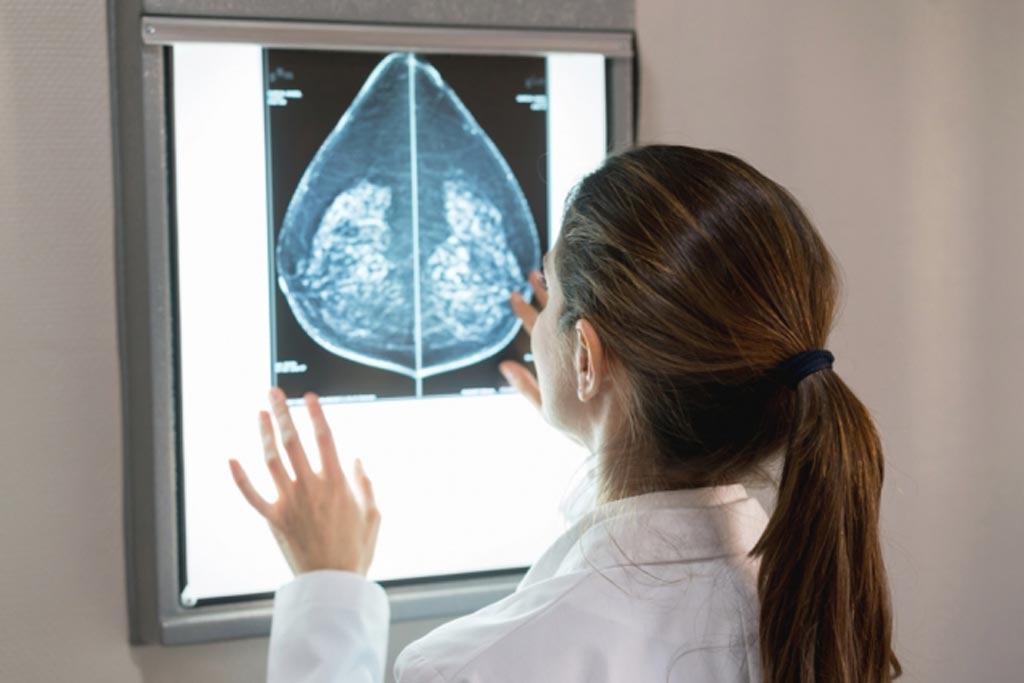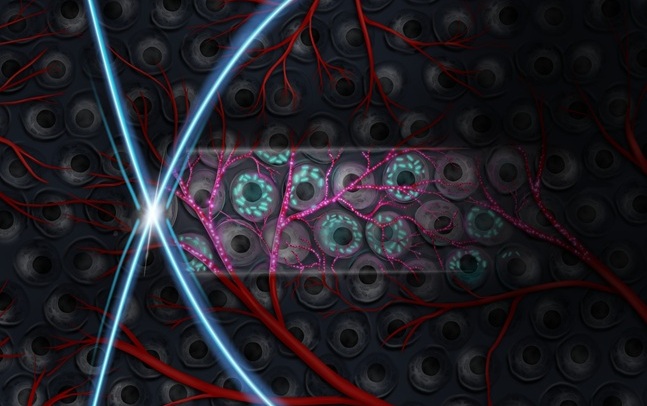Automated System Identifies Dense Breast Tissue
|
By MedImaging International staff writers Posted on 29 Oct 2018 |

Image: An artificial intelligence algorithm can detect dense breast tissue (Photo courtesy of MIT).
A deep-learning (DL) automated model can assess dense breast tissue in mammograms as reliably as expert radiologists, claims a new study.
Developed by researchers at the Massachusetts Institute of Technology (MIT, Cambridge, MA, USA) and Harvard Medical School (HMS; Boston, MA, USA), the DL model is based on a deep convolutional neural network (CNN) trained to assess breast imaging reporting and data system (BI-RADS) breast density--i.e. fatty, scattered, heterogeneous, and dense--based on the expert interpretation of 41,479 digital screening mammograms obtained in 27,684 women from January 2009 to May 2011. The algorithm was then tested on a held-out test set of 8,677 mammograms in 5,741 women.
In addition, five radiologists performed a reader study on 500 mammograms randomly selected from the test set. Finally, the algorithm was implemented in routine clinical practice, where eight radiologists reviewed 10,763 consecutive mammograms assessed with the model. Agreement on BI-RADS category was compared for three sets of readings: radiologists in the test set, radiologists working in consensus in the reader study set, and radiologists in the clinical implementation set. The readings were compared across 5,000 bootstrap samples to assess significance.
The results revealed that the DL model showed good agreement with radiologists in the test set, and with radiologists in consensus in the reader study set. In addition, there was very good agreement with the radiologists in the clinical implementation set; for binary categorization of dense or non-dense breasts, 10,149 of 10,763 (94%) of DL assessments were accepted by the interpreting radiologist. On all four BI-RADS categories, the DL algorithm matched radiologists' assessments at 90%. The study was published on October 16, 2018, in Radiology.
“Breast density is an independent risk factor that drives how we communicate with women about their cancer risk. Our motivation was to create an accurate and consistent tool that can be shared and used across health care systems,” said study author PhD student Adam Yala, of the MIT Computer Science and Artificial Intelligence Laboratory (CSAIL). “When radiologists pull up a scan at their workstations, they'll see the model's assigned rating, which they then accept or reject. It takes less than a second per image ... [and it can be] easily and cheaply scaled throughout hospitals.”
It is estimated that more than 40% of women have dense breast tissue, which alone increases the risk of breast cancer. Moreover, dense tissue can mask cancers on the mammogram, making screening more difficult.
Related Links:
Massachusetts Institute of Technology
Harvard Medical School
Developed by researchers at the Massachusetts Institute of Technology (MIT, Cambridge, MA, USA) and Harvard Medical School (HMS; Boston, MA, USA), the DL model is based on a deep convolutional neural network (CNN) trained to assess breast imaging reporting and data system (BI-RADS) breast density--i.e. fatty, scattered, heterogeneous, and dense--based on the expert interpretation of 41,479 digital screening mammograms obtained in 27,684 women from January 2009 to May 2011. The algorithm was then tested on a held-out test set of 8,677 mammograms in 5,741 women.
In addition, five radiologists performed a reader study on 500 mammograms randomly selected from the test set. Finally, the algorithm was implemented in routine clinical practice, where eight radiologists reviewed 10,763 consecutive mammograms assessed with the model. Agreement on BI-RADS category was compared for three sets of readings: radiologists in the test set, radiologists working in consensus in the reader study set, and radiologists in the clinical implementation set. The readings were compared across 5,000 bootstrap samples to assess significance.
The results revealed that the DL model showed good agreement with radiologists in the test set, and with radiologists in consensus in the reader study set. In addition, there was very good agreement with the radiologists in the clinical implementation set; for binary categorization of dense or non-dense breasts, 10,149 of 10,763 (94%) of DL assessments were accepted by the interpreting radiologist. On all four BI-RADS categories, the DL algorithm matched radiologists' assessments at 90%. The study was published on October 16, 2018, in Radiology.
“Breast density is an independent risk factor that drives how we communicate with women about their cancer risk. Our motivation was to create an accurate and consistent tool that can be shared and used across health care systems,” said study author PhD student Adam Yala, of the MIT Computer Science and Artificial Intelligence Laboratory (CSAIL). “When radiologists pull up a scan at their workstations, they'll see the model's assigned rating, which they then accept or reject. It takes less than a second per image ... [and it can be] easily and cheaply scaled throughout hospitals.”
It is estimated that more than 40% of women have dense breast tissue, which alone increases the risk of breast cancer. Moreover, dense tissue can mask cancers on the mammogram, making screening more difficult.
Related Links:
Massachusetts Institute of Technology
Harvard Medical School
Latest General/Advanced Imaging News
- AI-Powered Imaging System Improves Lung Cancer Diagnosis
- AI Model Significantly Enhances Low-Dose CT Capabilities
- Ultra-Low Dose CT Aids Pneumonia Diagnosis in Immunocompromised Patients
- AI Reduces CT Lung Cancer Screening Workload by Almost 80%
- Cutting-Edge Technology Combines Light and Sound for Real-Time Stroke Monitoring
- AI System Detects Subtle Changes in Series of Medical Images Over Time
- New CT Scan Technique to Improve Prognosis and Treatments for Head and Neck Cancers
- World’s First Mobile Whole-Body CT Scanner to Provide Diagnostics at POC
- Comprehensive CT Scans Could Identify Atherosclerosis Among Lung Cancer Patients
- AI Improves Detection of Colorectal Cancer on Routine Abdominopelvic CT Scans
- Super-Resolution Technology Enhances Clinical Bone Imaging to Predict Osteoporotic Fracture Risk
- AI-Powered Abdomen Map Enables Early Cancer Detection
- Deep Learning Model Detects Lung Tumors on CT
- AI Predicts Cardiovascular Risk from CT Scans
- Deep Learning Based Algorithms Improve Tumor Detection in PET/CT Scans
- New Technology Provides Coronary Artery Calcification Scoring on Ungated Chest CT Scans
Channels
Radiography
view channel
AI-Powered Imaging Technique Shows Promise in Evaluating Patients for PCI
Percutaneous coronary intervention (PCI), also known as coronary angioplasty, is a minimally invasive procedure where small metal tubes called stents are inserted into partially blocked coronary arteries... Read more
Higher Chest X-Ray Usage Catches Lung Cancer Earlier and Improves Survival
Lung cancer continues to be the leading cause of cancer-related deaths worldwide. While advanced technologies like CT scanners play a crucial role in detecting lung cancer, more accessible and affordable... Read moreMRI
view channel
Ultra-Powerful MRI Scans Enable Life-Changing Surgery in Treatment-Resistant Epileptic Patients
Approximately 360,000 individuals in the UK suffer from focal epilepsy, a condition in which seizures spread from one part of the brain. Around a third of these patients experience persistent seizures... Read more
AI-Powered MRI Technology Improves Parkinson’s Diagnoses
Current research shows that the accuracy of diagnosing Parkinson’s disease typically ranges from 55% to 78% within the first five years of assessment. This is partly due to the similarities shared by Parkinson’s... Read more
Biparametric MRI Combined with AI Enhances Detection of Clinically Significant Prostate Cancer
Artificial intelligence (AI) technologies are transforming the way medical images are analyzed, offering unprecedented capabilities in quantitatively extracting features that go beyond traditional visual... Read more
First-Of-Its-Kind AI-Driven Brain Imaging Platform to Better Guide Stroke Treatment Options
Each year, approximately 800,000 people in the U.S. experience strokes, with marginalized and minoritized groups being disproportionately affected. Strokes vary in terms of size and location within the... Read moreUltrasound
view channel
Ultrasound-Based Microscopy Technique to Help Diagnose Small Vessel Diseases
Clinical ultrasound, commonly used in pregnancy scans, provides real-time images of body structures. It is one of the most widely used imaging techniques in medicine, but until recently, it had little... Read more
Smart Ultrasound-Activated Immune Cells Destroy Cancer Cells for Extended Periods
Chimeric antigen receptor (CAR) T-cell therapy has emerged as a highly promising cancer treatment, especially for bloodborne cancers like leukemia. This highly personalized therapy involves extracting... Read moreNuclear Medicine
view channel
Novel PET Imaging Approach Offers Never-Before-Seen View of Neuroinflammation
COX-2, an enzyme that plays a key role in brain inflammation, can be significantly upregulated by inflammatory stimuli and neuroexcitation. Researchers suggest that COX-2 density in the brain could serve... Read more
Novel Radiotracer Identifies Biomarker for Triple-Negative Breast Cancer
Triple-negative breast cancer (TNBC), which represents 15-20% of all breast cancer cases, is one of the most aggressive subtypes, with a five-year survival rate of about 40%. Due to its significant heterogeneity... Read moreImaging IT
view channel
New Google Cloud Medical Imaging Suite Makes Imaging Healthcare Data More Accessible
Medical imaging is a critical tool used to diagnose patients, and there are billions of medical images scanned globally each year. Imaging data accounts for about 90% of all healthcare data1 and, until... Read more
Global AI in Medical Diagnostics Market to Be Driven by Demand for Image Recognition in Radiology
The global artificial intelligence (AI) in medical diagnostics market is expanding with early disease detection being one of its key applications and image recognition becoming a compelling consumer proposition... Read moreIndustry News
view channel
GE HealthCare and NVIDIA Collaboration to Reimagine Diagnostic Imaging
GE HealthCare (Chicago, IL, USA) has entered into a collaboration with NVIDIA (Santa Clara, CA, USA), expanding the existing relationship between the two companies to focus on pioneering innovation in... Read more
Patient-Specific 3D-Printed Phantoms Transform CT Imaging
New research has highlighted how anatomically precise, patient-specific 3D-printed phantoms are proving to be scalable, cost-effective, and efficient tools in the development of new CT scan algorithms... Read more
Siemens and Sectra Collaborate on Enhancing Radiology Workflows
Siemens Healthineers (Forchheim, Germany) and Sectra (Linköping, Sweden) have entered into a collaboration aimed at enhancing radiologists' diagnostic capabilities and, in turn, improving patient care... Read more


















